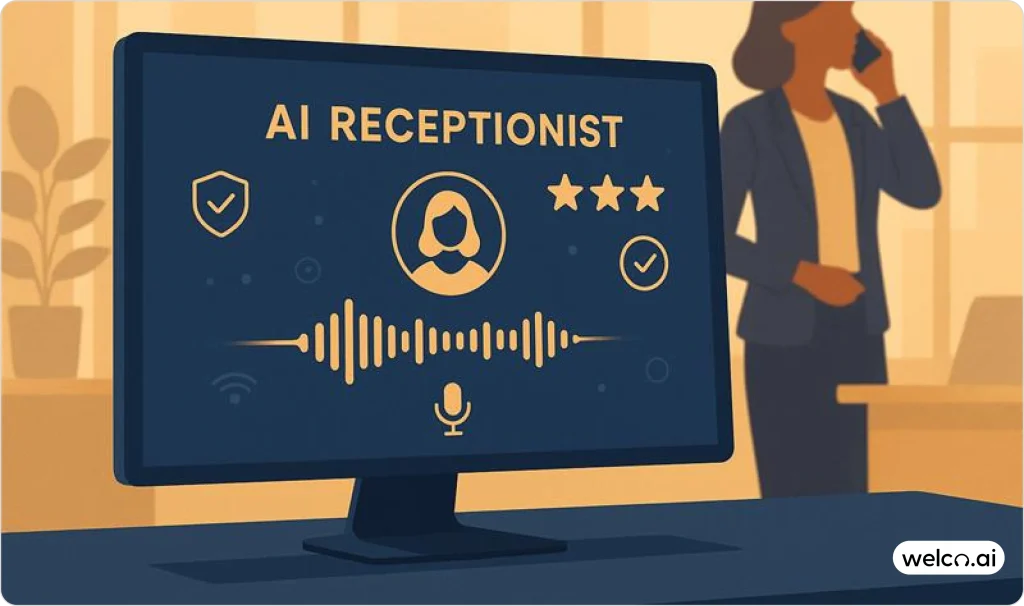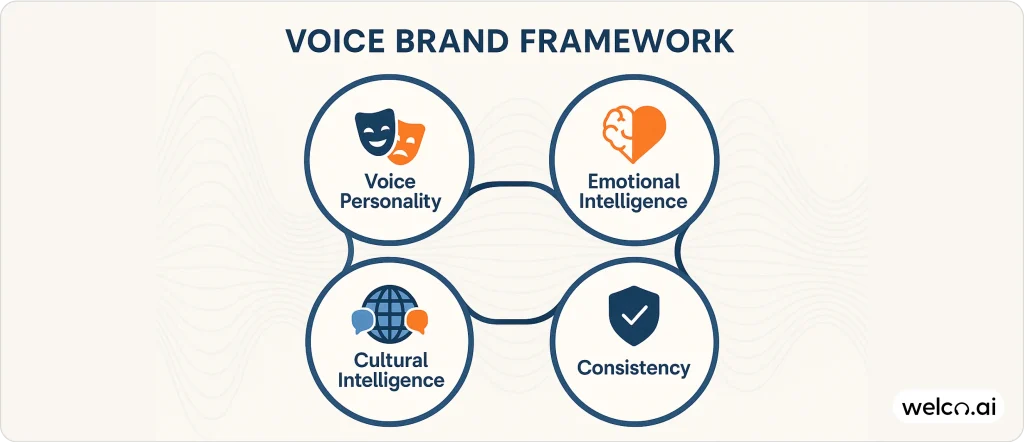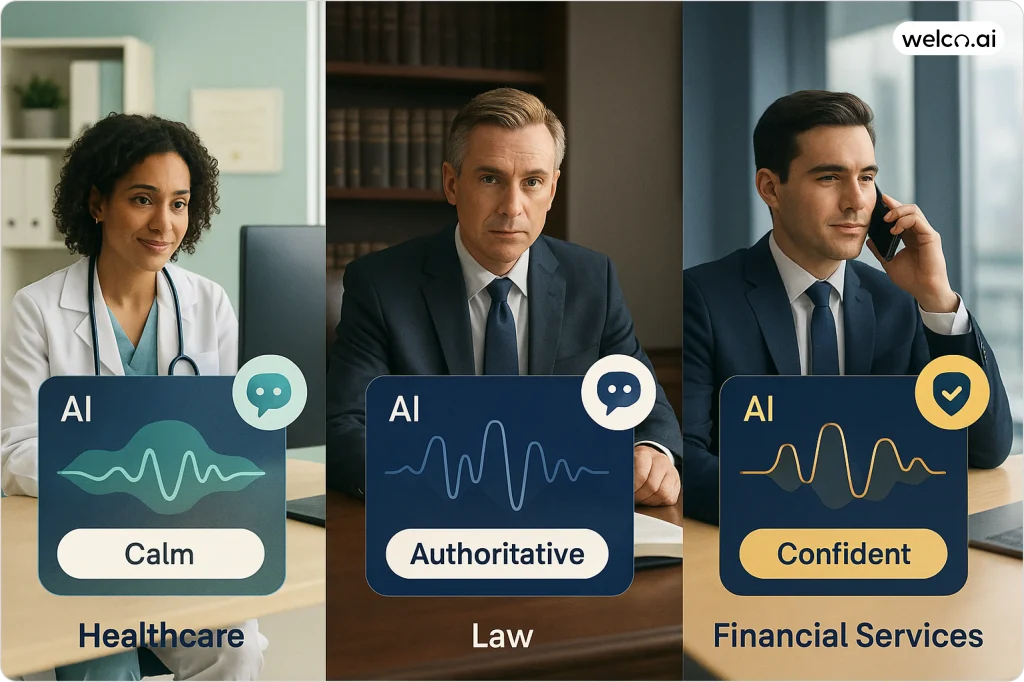The $75,000 Client Who Hung Up in 3 Seconds
Sarah Chen almost lost her biggest real estate client because her AI receptionist sounded like a discount service. The luxury property investor called her boutique firm, heard a generic robotic voice, and immediately hung up thinking “These people don’t understand my market.”
Within hours, that same client signed with a competitor whose AI assistant greeted callers with sophisticated authority: “Good afternoon, you’ve reached Sterling Properties, where we specialize in premium investment opportunities. How may I assist you with your portfolio today?”
Sarah’s wake-up call cost her $75,000 in commission. But it taught her something crucial: voice brand identity isn’t about technology—it’s about psychology.
Your voice creates instant trust or destroys it faster than any other brand element. MIT research shows humans judge trustworthiness and competence within seconds of hearing a voice. Your potential customers are making buying decisions before they even know your name.
Understanding how first impressions are formed in those critical opening moments becomes essential for developing effective voice brand strategies that build immediate trust.

The Psychology Behind Voice Brand Identity
When someone calls your business, their brain instantly processes three critical elements:
Tone: Does this sound confident or uncertain? Warm or cold? Professional or amateur?
Pace: Is this rushed and anxious, or measured and calm? Frantic or composed?
Clarity: Does this convey competence and authority, or confusion and unprofessionalism?
Here’s what most business owners don’t realize: these judgments happen faster than conscious thought. Before customers can even process your words, they’ve already decided whether you’re trustworthy enough to solve their problems.
A pediatric dental practice in Austin discovered this firsthand. Patient feedback revealed their phone system made them sound “like a discount clinic.” After developing a warm, child-friendly voice identity with pediatric-specific conversation patterns, new patient bookings increased 43% in three months.
Like Martinez Law Firm, whose clients kept saying they “sounded like an ambulance chaser” until they developed an authoritative yet compassionate voice that increased referrals by 60%.
The difference wasn’t technology—it was intentional voice brand development.
The Voice Brand Identity Framework
After analyzing successful voice strategies across 12 industries, we’ve identified four essential elements that separate memorable brands from forgettable ones:
1. Voice Personality Definition
Your voice personality should reflect your brand values while meeting customer expectations for your industry.
Luxury brands sound authoritative and refined—think private banking or high-end real estate. Their AI voices use measured pacing, sophisticated vocabulary, and confident tone that signals exclusivity and expertise.
Tech startups sound energetic and approachable—innovative but accessible. Their voices use faster pacing, casual language, and enthusiastic tone that conveys innovation and friendliness.
Healthcare practices sound caring but competent—empathetic yet professional. Their voices use calm pacing, reassuring tone, and clear communication that builds trust in medical expertise.
Legal services balance authority with approachability—knowledgeable but not intimidating. Their voices use professional vocabulary without jargon, confident tone, and respectful pacing.

2. Emotional Intelligence Integration
Different customer emotions require different voice responses. Your brand identity should include protocols for adapting to caller emotional states.
Distressed customers need slower, more reassuring tones with empathetic language patterns.
Excited customers benefit from matching their energy while maintaining professionalism.
Confused customers require patient, educational approaches with clear, simple explanations.
Urgent customers need immediate acknowledgment of their situation with efficient, action-oriented responses.
For businesses that frequently handle challenging emotional situations, developing skills in managing complex customer interactions becomes crucial for maintaining voice brand consistency during difficult conversations.
3. Cultural Intelligence
Voice brand identity extends beyond language to cultural communication patterns.
American business culture expects efficiency with warmth—direct but friendly communication.
Japanese business culture demands extreme politeness markers and formal interaction patterns.
Mediterranean cultures expect more animated delivery and personal connection.
Nordic cultures prefer straightforward, no-nonsense communication with minimal small talk.
Organizations serving diverse customer bases can benefit significantly from implementing comprehensive multilingual AI capabilities that go beyond voice brand identity to include full cultural and language adaptation.
4. Consistency Across All Interactions
Your voice brand identity should remain consistent whether handling routine inquiries, emergency situations, or complex questions. This consistency builds trust through predictable, reliable experiences.
Understanding the psychology behind call routing decisions helps ensure that voice brand consistency is maintained even when calls need to be transferred or escalated to different team members.
Voice Brand Examples That Work
Let’s examine how different industries successfully develop distinct voice identities:

Healthcare: Building Trust Through Empathy
Brand Promise: “We care about your health and understand medical concerns can be frightening.”
Voice Characteristics:
- Calm, reassuring tone that reduces anxiety
- Patient pacing that doesn’t rush worried callers
- Warm but professional delivery
- Clear explanations without medical jargon
Example Script: “Thank you for calling Westside Family Practice. I understand health concerns can’t wait, and I’m here to help you right away. What brings you in today?”
For healthcare practices looking to enhance their voice brand with advanced capabilities, implementing comprehensive personalization strategies can significantly improve patient satisfaction and trust-building during phone interactions.
Legal Services: Authority with Approachability
Brand Promise: “We have the expertise to handle your legal matter while treating you with respect and understanding.”
Voice Characteristics:
- Confident tone that conveys legal expertise
- Professional vocabulary without intimidating jargon
- Respectful pacing that shows clients are valued
- Adaptable delivery for emotional situations
Example Script: “Welcome to Wilson Legal. All our conversations are completely confidential. I understand you’re seeking legal guidance, and I’m here to connect you with the right attorney for your specific situation.”
Financial Services: Security with Personal Touch
Brand Promise: “Your financial security is our priority, and we provide trustworthy guidance for your most important decisions.”
Voice Characteristics:
- Authoritative tone that inspires confidence
- Measured pacing that suggests careful consideration
- Clear communication about complex topics
- Security-focused language that builds trust
Example Script: “Good morning, and thank you for calling Sterling Financial. Your financial security is our priority. How may I help you achieve your financial goals today?”
Your Voice Brand Development Worksheet
Use this framework to define your unique voice identity:
Step 1: Brand Personality Assessment
What three words best describe your ideal customer experience?
- Examples: Trustworthy, efficient, caring OR innovative, energetic, accessible
What emotions should customers feel after talking with you?
- Confident in your expertise
- Comfortable with your approach
- Excited about working together
- Relieved that you understand their situation
How formal or casual should your interactions be? (Rate 1-5, where 1 = Very Casual, 5 = Very Formal)
- 1-2: Casual and approachable (creative services, startups)
- 3: Professional but friendly (most service businesses)
- 4-5: Formal and professional (legal, financial, medical)
Select your primary voice personality traits (choose 3-4): □ Authoritative □ Warm □ Energetic □ Calm
□ Professional □ Friendly □ Confident □ Empathetic
□ Innovative □ Trustworthy □ Approachable □ Sophisticated
Action Item: Write a one-sentence description of your ideal voice personality based on your selections above.
Step 2: Customer Emotional Journey Mapping
What emotional state are customers typically in when they call? (Check all that apply) □ Stressed about problems they need solved □ Excited about opportunities □ Confused about options □ Urgent about timing □ Frustrated with previous experiences □ Hopeful about solutions
How should your voice adapt to these emotions?
- Stressed customers: Slower pace, reassuring tone, immediate acknowledgment
- Excited customers: Match energy while maintaining professionalism
- Confused customers: Patient explanations, educational approach
- Urgent customers: Efficient responses, action-oriented language
Action Item: Create specific response scripts for your top 2 customer emotional states.
Step 3: Industry and Cultural Considerations
What communication style does your industry expect? □ Professional authority (legal, medical, financial) □ Friendly expertise (service businesses) □ Innovative energy (technology, creative) □ Other: _______________
What cultural considerations affect your customer base? □ Formal vs. informal communication preferences □ Direct vs. relationship-focused approaches □ Individual vs. family decision-making patterns □ Specific cultural groups: _______________
Action Item: Define 2-3 specific voice adaptations for your primary customer demographics.
Implementation Strategies That Work
Start with Your Brand Guidelines
If you already have brand guidelines, your voice identity should complement your visual brand. Conservative visual brands typically need authoritative, professional voices. Creative visual brands can use more energetic, approachable voices.
Test Different Voice Approaches
Record sample greetings in different styles and test them with existing customers. Ask specific questions:
- Does this voice sound trustworthy?
- Would you feel comfortable doing business with this company?
- Does this match your expectations for our industry?
Voice Consistency Testing: Record yourself or your team delivering the same message in different emotional states. Does your voice brand remain consistent when handling a frustrated customer versus an excited one? This exercise reveals gaps between your intended voice identity and actual delivery.
Train Your Team on Voice Consistency
Whether using AI or human receptionists, everyone representing your brand should understand and embody your voice identity. Create specific guidelines for:
- Greeting scripts that reflect your brand personality
- Response patterns for different customer emotions
- Escalation procedures that maintain brand voice
- Language choices that reinforce your brand values
Monitor and Optimize
Voice brand identity isn’t set-and-forget. Regularly evaluate:
- Customer satisfaction with phone interactions
- Conversion rates from phone calls to appointments/sales
- Feedback about how your business “sounds” to customers
- Consistency across different team members or systems
Businesses looking to maximize their voice brand effectiveness should also consider 24/7 customer service optimization strategies that ensure consistent brand experiences across all hours of operation.
Common Voice Brand Mistakes to Avoid
Generic “Professional” Approach
The Problem: Trying to sound “professional” without defining what that means for your specific brand and customers.
The Fix: Define specific personality traits that differentiate you from competitors while meeting customer expectations.
Ignoring Customer Emotional States
The Problem: Using the same voice approach regardless of whether customers are stressed, excited, confused, or urgent.
The Fix: Develop response patterns that adapt to customer emotions while maintaining your core brand identity.
Inconsistency Across Touchpoints
The Problem: Your AI sounds professional, but your human staff sounds casual, creating confusing brand experiences.
The Fix: Train all customer-facing team members on your voice brand guidelines and expectations.
Cultural Mismatches
The Problem: Using American casual communication styles with customers from formal business cultures, or vice versa.
The Fix: Understand your customer demographics and adapt communication styles appropriately while maintaining your core brand identity.
Measuring Voice Brand Success
Track these metrics to evaluate your voice brand effectiveness:
Customer Satisfaction Scores for phone interactions specifically
Conversion Rates from phone calls to appointments or sales
Customer Retention and referral rates
Brand Perception feedback about how your business “sounds”
Competitive Differentiation in how customers describe your service
Successful voice brand development typically shows measurable improvements within 30-60 days of implementation.
Your Next Steps
Voice brand identity development isn’t just about sounding professional—it’s about creating consistent, trustworthy experiences that build customer relationships from the very first interaction.
Start by completing the voice brand development worksheet above. Define your brand personality, map customer emotional journeys, and consider industry and cultural factors that affect your communication.
Remember Sarah Chen’s $75,000 lesson: in a world where customers make instant judgments, your voice brand identity determines whether you build trust or lose opportunities in those critical first three seconds.
Don’t let another potential customer hang up because your voice doesn’t match their expectations. Develop a voice brand identity that builds instant trust and turns every phone interaction into a relationship-building opportunity.For businesses ready to implement these voice brand strategies with advanced technology, understanding the journey mapping framework for AI implementation can help ensure successful deployment while maintaining authentic brand voice throughout the process.
Frequently Asked Questions
My business doesn’t have a clear brand identity yet. Do I need to develop my visual brand before working on voice brand identity?
Not necessarily. Voice brand identity can actually help clarify your overall brand strategy. Start with the voice personality traits that feel authentic to your business values and customer needs. Many successful businesses discover their core brand identity through voice development because speaking patterns reveal authentic personality traits more naturally than visual elements.
Focus on how you want customers to feel during interactions, then ensure your visual brand eventually aligns with that voice personality.
We have multiple team members answering phones with completely different communication styles. How do I create consistency without changing everyone’s personality?
This is one of the most common challenges. Create voice brand guidelines that focus on principles rather than scripts. Instead of telling everyone to sound exactly the same, establish consistent approaches to:
- Greeting structure (warm acknowledgment + company identity + offer to help)
- Emotional response patterns (how to handle stressed, excited, or confused customers)
- Key language choices that reinforce your brand values
- Escalation procedures that maintain brand voice
Train team members to adapt these principles to their natural communication styles while hitting the same brand touchpoints.
Our customers come from very different cultural backgrounds. How do I develop one voice identity that works for everyone?
Develop a core voice identity that represents your brand values, then create cultural adaptation guidelines. For example, your core identity might be “professional and caring,” but you’d express this differently:
- With formal cultures: More structured greetings, respectful titles, patient pacing
- With relationship-focused cultures: Warmer small talk, family-oriented language
- With direct cultures: Efficient communication, immediate problem-solving focus
The key is maintaining your core brand personality while adapting the delivery method to cultural communication preferences.
I’m worried that focusing too much on voice personality will make our interactions feel fake or scripted. How do I keep it natural?
The goal isn’t to create robotic scripts but to establish authentic communication principles. Good voice brand identity feels more natural, not less, because it aligns your team’s communication with your genuine business values. Start with personality traits that already exist in your business culture. If your team naturally tends to be helpful and thorough, build your voice identity around those authentic characteristics rather than trying to impose completely foreign traits. Practice voice guidelines through role-playing exercises where team members handle different scenarios while maintaining brand personality. This builds natural fluency rather than forced adherence to scripts.
How do I measure whether our voice brand identity is actually working, especially if we’re a small business without fancy analytics?
You don’t need expensive tools to track voice brand effectiveness. Simple measurement methods include:
- Ask customers directly: “How did you feel about your phone experience with us?” during follow-up calls or in person
- Track conversion patterns: Are more phone calls turning into appointments or sales?
- Monitor staff feedback: Are team members feeling more confident and consistent in customer interactions?
- Notice customer language: Do customers start describing your business with the same personality traits you’re trying to project?
Keep a simple log for 30 days noting customer reactions during phone calls. Look for patterns in satisfaction, questions asked, and willingness to move forward with your services.
